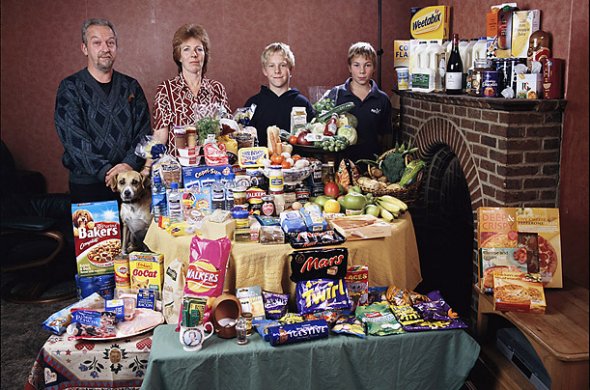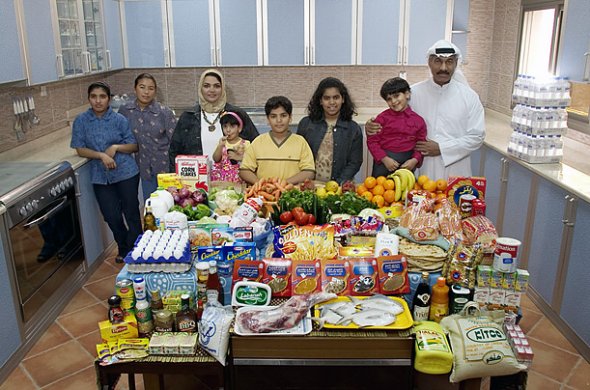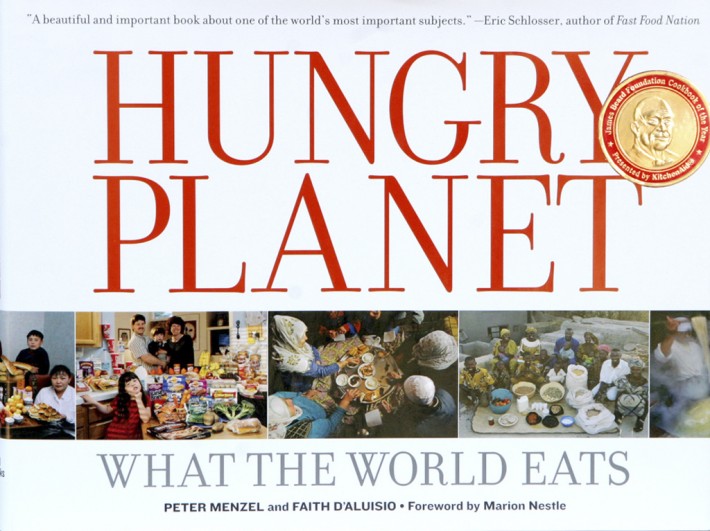It seems as a people, we have a fascination with photographing our food. From Henry's series of riders, to looking on instagram we cant help but document what we consume. Photographer Peter Menzel started this intriguing series of one weeks of groceries from around the world, taking traditional food photography to a much larger scale. In his book Hungry Planet, Peter explores both the cultural differences of diets around the world as well investigating how prosperity and poverty influence the diets of different nations.
Here is the book description of Menzel's amazing project:
The age-old practice of sitting down to a family meal is undergoing unprecedented change as rising world affluence and trade, along with the spread of global food conglomerates, transform eating habits worldwide. HUNGRY PLANET profiles 30 families from around the world--including Bosnia, Chad, Egypt, Greenland, Japan, the United States, and France--and offers detailed descriptions of weekly food purchases; photographs of the families at home, at market, and in their communities; and a portrait of each family surrounded by a week's worth of groceries. Featuring photo-essays on international street food, meat markets, fast food, and cookery, this captivating chronicle offers a riveting look at what the world really eats.

Mexico

Great Britain

USA

Australia

Germany

Italy

Canada

France

Japan

China

Poland

Kuwait

Mongolia

Turkey

View the entire series Here in Menzel's Book Hungry Planet.
If you're passionate about taking your photography to the next level but aren't sure where to dive in, check out the Well-Rounded Photographer tutorial where you can learn eight different genres of photography in one place. If you purchase it now, or any of our other tutorials, you can save a 15% by using "ARTICLE" at checkout.








I think that the photos represent the middle class in USA, but in many of the other countries, it would be the middle to upper class. The photos should have been taken from the "majority's"economic level, if that makes sense.
I disagree, they all look very average for their countries to me. What exactly makes you believe they're upper middle class?
Maybe your expectations for how poor people should be elsewhere are wrong.
I don't think these photos represent any specific class or average family. Having lived in South America for many years, I can tell you that the photos from Guatemala and Ecuador are from very rural areas. An "average" city/suburb family would have a lot more processed foods
Thank you Chris! At first I was assuming these were all "average" families as I scrolled through and got excited when I saw Ecuador because my family is from there. Chris is right- that is a family from a very rural and poorer area. Unlike what most people that haven't lived or traveled there extensively think, Ecuador actually does have a middle class. Not a huge one, but it's there. Another thing to note is that my husband is Indian and can confirm that the family pictured would not be considered "average" either. Not that I still did not enjoy seeing these pics, it's an awesome idea, I just wish they had provided an explanation of why they chose each family.
I was thinking the same thing! I shared this link with my boyfriend and while trying to explain why I sort of realized that I wasn't sure if the aim was to show how much food a given family goes through (and let's face it, obviously a family that has twice as many kids, or grandparents living with them is going to go through more food than a smaller family with just one or two parents, and a couple kids. I also wasn't sure if the point was to showcase how comparatively little a family in Chad for example, has per week compared to more developed nations. Or, was it to showcase how much more prevalent processed foods are in places like the US. There should have been a few constants, e.g. like maybe all middle class, or all the same whether living in cities or suburbs, or even similar family size. Like I said, a family with many more people will generally have a little more. So if they had used similar size families across the board, I think it might have made for a more interesting comparison.
Exactly, Chris! These were handpicked families, the photographer is apparently either biased as to what he wants portrayed, or he's ignorant of what is the typical family's food in some of these countries.
Well said Arturo. As Americans, not only do we eat more processed foods; we also believe everyone is poorer than us. We are not richer... we just borrow more money.
im not sure how accurate this is as the German family definitely wouldnt have 4 bottles of wine and 30 beers between the mother and father a week.
I don't think they're meant to represent the average German family, but it would be reality for some families.
and in france they drink no wine at all... yeah sure......
LOL Luther, too right!
I don't know if that's average but they do drink a lot of beer. Most people do not drink to get drunk but as a "supplement" to their meal. I have seen people drink a glass of beer at lunch here and they sell beer pretty much everywhere. It's a different "drinking culture" here.
I'm disturbed about what is displayed in the "USA" photo. The amount of junk food and processed food is ridiculously disgusting. Our family doesn't eat that much junk in a year's time, let alone a month. Where are all the fruits/veggies? Are we just a wonky health-nut family? Is this truly how the majority of the country eats? No wonder we have such poor health & rampant obesity.
Don't assume a picture of one family represents a whole nation. You'd get a totally different image if the same project was done with the people I know.
This is, sadly, a very good example of the average American diet. I know a lot of families that eat a lot better, and plenty that eat worse.
I know that my family's groceries used to look similar while I was growing up, although still not quite that bad with more fruits and veggies and bread, and a lot less soda. Still a ton of packaged and processed and preserved foods though. I got smart to how bad we were eating in highschool. Happy to say they do much better now, still 7 years since I've moved out.
I wonder how much work the photographer did to research what an "average" diet looks like, and if that was what he was going for.
America is too big of a country and too diverse to be accurately represented by one family's weekly grocery purchases. We don't eat as poorly as the American photo represents nor do I know anyone who does. Makes me skeptical about the photos and representations for all the other countries as well.
While I agree with you, I think it's important to consider whether that photo represents the greater portion of the American population or you and your family do. I fear that unhealthy options are too easily available and busy parents do not have the time to shop for healthier options (or we are, on the whole, more unaware of them). I would wonder where your family falls on this spectrum, as it sounds like you do a great job of avoiding bad foods and seeking out good ones. I don't think this calls into question the other photographs...maybe we just need a few more for the US. After all, only two countries in that list are larger than us.
Really valid point you've raised here. Because of the relative size of the population, the "average" is a much bigger middle ground than what it would be in a relative smaller population size. As such, that is why we see so many outcries from Americans who eat healthy.
Another thing I'm curious about, is if that is the average American family, that means that there are a lot of people who eat healthier than that, but also a lot of people who eat worse off than that. Curious to see what that side of the spectrum looks like.
I don't know... most of the families I know eat like that... so I guess you might be a little wonky.
Not all that much junk food, more on the go food. With two teenagers, and probably two parents working full time, more then likely there is a reason for that.
In my opinion, on the go food *is* junk food.
That's pretty average American diet... not the way we eat... but definitely the great majority of people in the US eat similar to that.
The photographer is biased and wants to use a junk food family to portray his views. It's definitely not a typical USA family from any area near where I lived
The UK and Canadian familes aren't doing too well in that regard either. Tons of processed junk in those pictures.
By the time I got to Canada I thought we were doing pretty good! I'll have to go back and take another look.. :D
Nor Japan for that matter. With the exception of a small line on the left, their diet is entirely comprised of pre-packaged processed foods.
It seems that way but you've got to remember that in Japan nearly EVERYTHING is pre-packaged, down to herbs and fruit. It's apparently hygienic !?
I'd start out by hiring someone (proficient in written English) to proofread this article.
So much for looking at the big picture!
I was thinking that, too. "Do you think it could of been differently?" is driving me bananas.
Speaking of bananas.... they say it's the wonder fruit, but at the same time there's too much sugar and stuff so don't eat them.. I get so confused!
I live in Ecuador and what you see there is very stereotyped.
So, what do you eat in Ecuador... I thought the picture was of a native Ecuadorian.
Similar income bracket-low, middle etc- in the different countries shown would have given a better reflection...
nice
Today I learned I want to eat like a Mongolian
hell yeah. that was my takeaway, too.
Most of the "food" from the USA appears to be processed poison. Where are the fresh fruits and vegetables? And why is the family smiling? Pure propaganda.
I expected China to be more propagandized. I wonder what $200 buys around the world?
I could eat in any one of these countries.I could eat in Chad or Mali, although I would not like it long term.
I dont see any Meat/Poultry/Seafood Items in the Indian Photograph. Sends out a wrong signal that the indian families buy only vegetarian items as Groceries
What is sad is that the families with the most people have the least amount of food. Some of them have way too much to be consumed in week for their size family.
So, how do I send some of my produce to Mali or Chad? I started out reading this a little snooty about how I drink less soda than the posters, and ended up feeling guilty and entitled. I guess we all just do the best we can where we're at...and have the obligation to help those having a harder time than us.
Interesting project but the photo quality is so bad that besides the fruits, veggies and drinks you can't see what the rest is...
I guess we all take away, what we take away.. To me, the people with the least, seemed a little happier. I guess its all relative.
The pets in the british, french and polish pictures can be considered as somewhat disturbing...
absolutly unimportant!!!
Because a similar series of picture was made years ago with an serious background,
how many food does a family have in one week, begin from the riches countries like USA /etc) till the poorest countries from africa...
This is old!
serious question here. This looks a lot more like the 'types' of food a family might eat in a week than the actual groceries from a week. This is a 'week' of food not a month right.. looks like a months of groceries. I think its a bit skewed since some are families of 4, and some are families of 12 (3x as much food)
americans eat more chemicals then natural food.. no wonder they are fat.